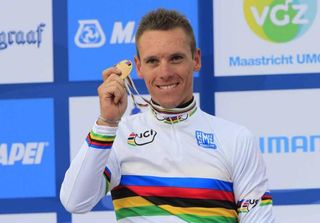Gilbert emerges from gloom with Cauberg solo attack
Belgian claims world title after a difficult season

After a difficult season, Philippe Gilbert emerged to see the stars atop the Cauberg at the end of the world championships road race. The Belgian unleashed a fierce acceleration midway up the race’s final climb and when he turned to assess the damage at the summit, he saw his rivals scattered across the hillside.
Even with 1.7km of false flat still to cover, there was already sense that it was a fait accompli. Alejandro Valverde (Spain) and Edvald Boasson Hagen (Norway) tried to get on terms, but with a tailwind at his back – and the frustrations of a difficult spring now behind him – Gilbert would not be caught.
“I did the perfect climb. I attacked at the right time. I’ll watch the images ten times to engrain it in my memory but it was a great moment,” Gilbert said afterwards. “I went just after the steep part of the climb with 2.2km still to go. It was very long to the finish but also very fast. I just stayed focused on my effort until 200 metres to go, when I knew it was for me.”
Cauberg history
Gilbert and the Cauberg have history, and not only because he has twice secured victory at the Amstel Gold Race on its slopes. In the darkness of his travails this spring, Gilbert had one of his few glimmers of light on the cavernous climb. Though suffering with the reality that his magical form of 2011 had suddenly and mysteriously abandoned him, Gilbert attempted to summon up some of the vim of old by attacking there in the finale of Amstel Gold Race. But like Samson, the return of his powers would prove short-lived, and his hopes of a third successive won crumbled all around him.
That was last April. By the time the world championships came around, Gilbert was a man utterly transformed. The rider who bounded over the summit of the Cauberg on Sunday seemed wholly unrelated to the labouring, beleaguered figure of last April.
“I was very disappointed after the spring classics because I was trying to find my best shape but I couldn’t get it,” Gilbert admitted. “It was hard but I kept working and trying, and in the end that paid off.”
Get The Leadout Newsletter
The latest race content, interviews, features, reviews and expert buying guides, direct to your inbox!
After his startling run of success in 2011 and his lucrative transfer to BMC during the off-season, Gilbert’s troubles became one of the most compelling stories of the spring, and would iron creases into his hitherto smooth relations with his home media.
“I have to thank my team because they never put pressure on me, even though I was a big transfer,” Gilbert said. “I wasn’t up to the level, but they put their faith in me, didn’t put any pressure on me and that allowed me to get back up to where I wanted to be, week by week, and to get back to the best of my form after a long battle with myself.”
The turning point
The turning point for Gilbert would come at the Tour de France. After facing a sea of notepads and microphones at the end of every race in the spring, he spent July in relative tranquillity, quietly working in the service of Cadel Evans, and slowly regaining his form.
An aggressive showing at the Olympic Games in London was a significant sign of life, and the confirmation would follow at the Vuelta a España. Remarkably, after 19 wins in 2011, his stage victories at Barcelona and La Lastrilla were his first of the season, but their value to Gilbert’s psyche must have been immeasurable.
“At the Olympics, I could already see that my best form was coming,” Gilbert said. “Then at the Vuelta, I won two stages with similar finishes to the Worlds. They were two good tests for me and I passed them well. That gave me a lot of confidence, and it also gave me a certain power to ensure my status in the team.”
Gilbert lined up on Sunday as co-leader of the Belgian team with Tom Boonen, and with the two stand-out performers of the past two classics campaigns in their ranks, only Spain had a comparable range of options. Even so, the beginnings were not auspicious. No Belgian rider made the early break, and when Alberto Contador led a 29-group clear with six laps to go, the onus again fell upon them to chase.
“Last night we said that we couldn’t let a group of more than six guys go away and no group with Spanish or Italians, but that’s what we did,” Gilbert said. “We were not happy but the guys had to ride. Then later on, we had only two guys [Gianni Meersman and Bjorn Leukemans] up there in the big group, which was not an ideal situation, so we had to ride.”
Two laps from the finish, the race came back together. The speed ratcheted upwards from there on in, and the final time up the Cauberg, Gilbert clawed his way out of the gloom towards the rainbow jersey.
“It’s hard to realise what it feels like,” Gilbert said, as he admired his jersey. “But I think I will feel the difference next Thursday in Piemonte. Then it will be a great, great moment for me.”

Barry Ryan was Head of Features at Cyclingnews. He has covered professional cycling since 2010, reporting from the Tour de France, Giro d’Italia and events from Argentina to Japan. His writing has appeared in The Independent, Procycling and Cycling Plus. He is the author of The Ascent: Sean Kelly, Stephen Roche and the Rise of Irish Cycling’s Golden Generation, published by Gill Books.
Most Popular

